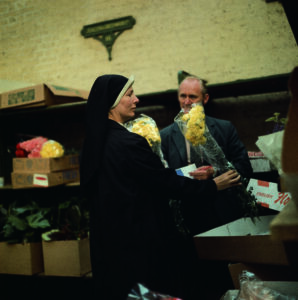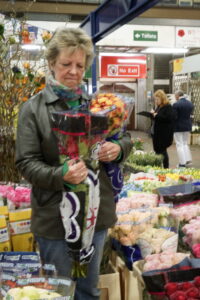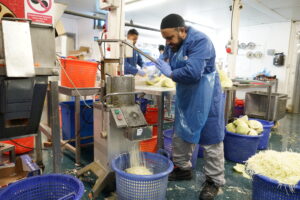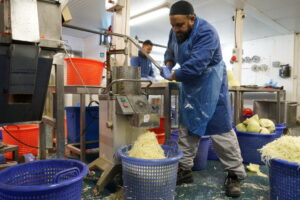Clive Boursnell has been taking pictures of Covent Garden Market since a late summer morning in 1968, when he found himself stood at the top of James Street by Long Acre at 5am. The street had been soaked by an early-morning rain shower and the fruit, veg and buyers and porters glistened in the rays of the sun, creating an entrancing scene that stole this photographer’s heart and has kept him enraptured ever since. As we celebrate the 50th anniversary of the Market’s move to Nine Elms, Clive is sharing some of his photography (and the stories behind it) with Market Times
A busy market provides a daily dose of 1,001 distractions, yet be it the seller, buyer, porter or as there is these days in the market, the food 'prepper', there are always those still moments of absolute concentration. That tender attention on the produce in hand lasts just a moment, yet in a night or day’s work, it is repeated so many times by all who work at New Covent Garden.

So, amidst the general organised chaos of market life, I can be seen looking for that still moment of total focus on the job in hand. I might be waiting a second, a minute or much longer, but I never stop looking for, perhaps, the buyer so lovingly, yet so clearly knowledgeable, sub-consciously drawing on years of dedication and experience while considering which box of artichokes to buy.
It is these very human moments that I seek to capture; this oft-under-rated facet of a most multi-faceted market. From this photographer’s perspective, to be there for these moments was first a question of building the trust of the market’s people, while continually increasing my own knowledge of how the market works. With the camaraderie, acceptance and trust of the market, I have been able to photograph the people of the market at very close quarters, at work, rest and sometimes even play without I hope becoming a distraction to them.
These are moments that I cannot set up, ask for or direct, the subject or subjects of the photo have to be themselves or themselves, without me overlaying or directing them, as far as possible unaware that I am capturing their work. I have to be distant to them, no matter how close I am, seeing and giving full attention to what is happening before my lens. My time building an understanding of the way people work in the market is crucial, as it creates the anticipation of when the moment will arrive, though I never know of course if all the elements that make a picture of such ‘at oneness’ will eventually hold the attention of the viewer.
To get that moment into the camera that says, 'this is the work that these people do'.


That moment when the Nun is considering the quality of the flowers while the seller gives his full, but slightly anxious attention, ahead of the hoped-for sale. Or Mairead, on the move with an armful of flowers yet suddenly caught by the sight of another bunch she considers for the briefest split second before moving on. She is in perfect balance, she and flowers are as one.

The longer moment as Sophie considers which, if any, wrap of flowers to have. Here it is more the facial expression that is key to telling us all about the decision making process as one arm holds an already selected wrap while the hands hold two flowers close together to inform the final choice. One wholesaler makes perhaps the final check he has all the fruit and veg he needs for the day, pencil in hand above the paperwork. It’s an evocative image, but also key to it is that the picture could only have been taken in Buyers' Walk, Nine Elms.
To this very day, I strictly frame each photograph as I take it. No picture is snapped with the idea that I can reshape or reframe the picture either in the darkroom or using photoshop later.
The whole process happens as I see the picture unfolding before me, recognising the star element and framing the shot to support the main point of the photograph.


The difference between an image that works and one that doesn’t is perhaps best illustrated by my last photographs here, in food prep. In the first, for me it is the position of the feet, the way the head and shoulders are hunched over the hands pushing the cabbage through the cutting machine and creating the blur of the cut cabbage falling into the plastic basket. This star action is supported by one full basket of uncut cabbage and one cut and ready-to-go. The second picture just fails as I miss the mesmerising movement of the cabbage falling into the basket. Please also note the lower eye level of the camera; shooting from a lower angle increases the stature and power of work and man.